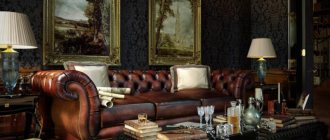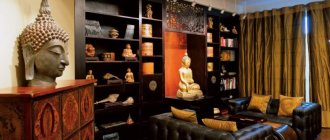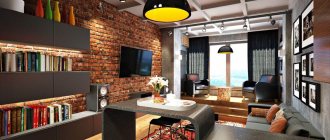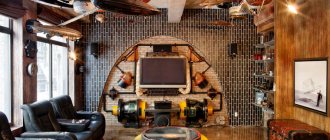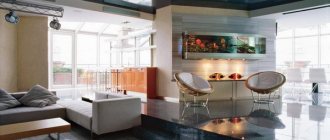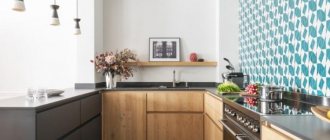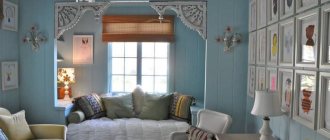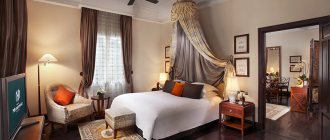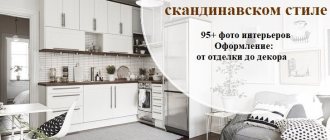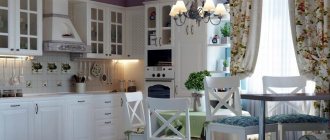What is kitsch?
Translated from German, the word “Kitsch” means bad taste, hack work, fakes. The term began to be used when elements of fine art began to be mass-produced, and their quality often left much to be desired.
Products that fell under the Kitsch term were sentimental, dramatic, and even cloying.
Many experts believe that the movement only imitates real art and is devoid of creativity; as such, there is no imagination here either. However, over time, kitsch appeared in the interior as an independent genre. Let's take a closer look at the history of its origin and production.
Kitsch style today
The main features of modern kitsch include: the absence of rules in interior design, the presence of a huge number of objects that are incompatible with each other either in color or style; disharmony of colors and shades, the presence of fakes of luxury, cheap materials mistaken for rarity, excess decor. Colors should not just be saturated, but piercingly bright. The more attributes of a beautiful life are collected in one room, the better. Modern designers have conventionally divided this style into three directions, depending on its purpose and method of execution:
- The lumpen style, born of poverty, combines old sofas, sagging armchairs, and shabby chairs that look like they were brought from a landfill. Lamp posts, street benches, road signs, and cheap decorative elements are acceptable in this direction. The poverty of the design is diluted with bright, rich, positive colors.
- The pseudo-luxury trend is characterized as a combination of wealth and lack of taste. Defiant gilding with plastic stucco, a fur carpet on marble, neon lighting of antique columns are quite compatible things for this style. Complete disregard for harmony is his hallmark.
- Designer kitsch is vibrant art for art's sake. This style trend is a kind of meaningful and thoughtful parody that clearly demonstrates contempt for generally accepted rules and canons. Only a true master of his craft can create kitsch in the interior without bringing it to the point of absurdity.
About style
One of the definitions of the word “kitsch” is pseudo-art designed for external effect. At the end of the 19th century, the concept meant mass production of art, cheap figurines, paintings imitating objects of art. It was a game of luxury, an imitation of the elite of society. Reproductions of famous paintings, commissioned from street artists, appeared in poor houses and hotels.
Molded frames painted with bronze paint replaced gilded baguettes. Later, plaster piggy banks, porcelain elephants and fish, and painted ceramics joined the items with a pretense of luxury.
In the USSR, these subjects were considered philistinism, and they tried to eradicate the external attributes of the bourgeoisie. But the style lived by its own laws, kitschy things coexisted with accessories made of glass and plastic, photographs of film actors, carpets, and strict rectangular furniture. The combination of these incompatible items helped to decorate dull walls and bring comfort to barracks, communal apartments, and Khrushchev-era apartment buildings. Today kitsch is a fashion trend, a mixture of Provence, modernism, retro, and functionalism.
The interior is created spontaneously or purposefully, and is conventionally divided into three directions.
Main types of kitsch style
Unconscious kitsch
We can distinguish spontaneous (unconscious) and intentional manifestations of the kitsch style in the interior. The latter can be divided into three categories.
Kitsch lumpen
Kitsch lumpen
A design movement emerging from poor neighborhoods. It is characterized by the widespread use of contrasting acid shades, graffiti, cheap interior items and street design elements - lamp posts, benches, road signs, telephone sets and even booths.
One of the signs is a combination of “incompatible” colors, like blue and red
One of its features is gilded foam columns. Bleak poverty is ennobled by bright and rich positive shades.
In such an interior you will not find a furniture set - all the furnishings are “worn” by life and chosen at random. The decor is represented by cheap trinkets. Lumpen kitsch can be described as the need to show unconventional thinking at a low standard of living.
Photo of a living room in a kitsch style, where antique carved furniture and outright consumer goods coexist
Advice. Most of all, such manifestations of kitsch are suitable for the design of a teenage room with its rebellious spirit and youthful maximalism. You can use graffiti, rich acidic shades, unusual versatile things in the form of a road sign or street sign.
Pseudo-luxury kitsch
Pseudo-luxurious kitsch in the dining room
This trend in the design of living space is characterized by a noticeable desire to create in any way the illusion of well-being in the absence of taste. In such an interior you can find golden stucco, bright velvet, Greek columns, fakes of expensive decorative elements, and cheap reproductions of famous paintings.
In this style, incompatible cultural layers are intertwined - a marble floor on which a fur carpet is laid or the use of neon lighting on antique columns.
Organization of a sleeping place
Natural finishing materials are deliberately replaced by their cheaper imitation.
Important! Fashionable natural elements in decoration, expensive furniture and luxurious accessories do not guarantee the formation of a conscious kitsch style - rather, it is an unconscious manifestation of it. For example, when combining a country-style fireplace, expensive oriental vases and modern fluorescent lamps.
Carved furniture and reproductions in “gilded” frames declare imaginary wealth
The manifestation of unconscious kitsch is typical for the interiors of bedrooms and kitchens.
Designer kitsch
Conscious kitsch
To achieve a subtle and ironic ridicule of specific concepts and phenomena, when creating a kitsch style, you must have professional design skills or innate taste. The result is a competent parody that preserves the meaningfulness and thoughtfulness of the interior.
This direction of the kitsch style is capable of demonstrating contempt for generally accepted rules in design, emphasizing the charisma and creative character of the owner of the house.
Design direction of kitsch in the living room
Important! Only a professional designer can prevent the kitsch style from being brought to its absurd degree.
This trend is the so-called conscious manifestation of the kitsch style, therefore only it has the title of a real design style - controversial, but rightfully occupying a separate place in the hierarchy of style trends. Many famous designers have experience in creating such interiors, but only the most experienced of them can master it.
A poster in a gilded carved frame is a clear sign of this shocking style
Provocative, ironic, hooligan, with a subtle mockery of the classics in design art, the intentional kitsch style is able to combine incompatible things. More often it can be found in the design of living rooms, kitchens or youth cafes.
Varieties of Kitsch style
Interior design in the Kitsch style is divided into “spontaneous” (unconscious) and “intentional”. Conventionally, it can be divided into three directions:
Kitsch lumpen
The kitsch of the lumpen is dictated by poverty. This includes mismatched furniture, outdated interior items, and cheap trinkets. Lumpen kitsch is an indicator of the author’s low standard of living and unconventional thinking.
A teenager's room can also be a hub of lumpen kitsch. The rebellious spirit and youthful maximalism here can manifest themselves in the form of graffiti and rich acid colors in the interior. There are also unusual, diverse items, many of which are very unexpected - for example, road signs or lamp posts.
Pseudo-luxury Kitsch
Pseudo-luxurious kitsch style is an interior design in which there is a noticeable desire to emphasize imaginary well-being by any means. This is an interior in the design of which, instead of natural finishing materials, their imitation is used. This is a room where numerous luxury items are presented, often of dubious quality.
And this is an interior that inept designers, wanting to put “the best on display,” “stuff” everything indiscriminately, forgetting about style.
The availability of funds, the use of the most fashionable natural finishing elements, expensive furniture and rich decorations also do not guarantee that the Kitsch style will not be formed in the end. If, for example, you place a Country-style fireplace, expensive oriental vases and modern fluorescent lamps in one interior, you will get an unconscious pseudo-luxurious Kitsch.
The kitchen and bedroom are the rooms in which unconscious kitsch is most often formed. Interior design always requires a professional approach and a sense of proportion.
Designer Kitsch
Design Kitsch is intentional. Only it can be considered a true interior design style. The style is controversial, but, nevertheless, it rightfully occupies its own separate niche in the art of interior design. The Kitsch style is found in the works of many famous designers. Only the most experienced of them can afford to resort to this style. After all, this is a kind of hooliganism, irony, a subtle mockery of the classical canons of design art, a provocation.
Intentional kitsch style is the ability to combine incompatible things. This is "art for art's sake." The kitchen, living room, youth cafe are the most popular places for experiments in the kitsch style.
Varieties of style
| View | Peculiarities |
| Kitsch lumpen | The direction is typical for people with low incomes and unconventional thinking. Furniture from different sets is repainted in radical colors, the bleak interior is diluted with bright colors, graffiti painting, cheap and flashy decor |
| Pseudo-luxury style | The room is decorated with objects that give the impression of originals: plastic forging, reproductions, fake gilding. Curtains and bedspreads with ruffles are adjacent to modern lamps, luxurious carved furniture - with photographs in chrome frames |
| Designer kitsch | Bold colors, contrasting elements, bronze and stone crafts, modern finishing materials, designer accessories, furniture from several eras are used. |
Who chooses the Kitsch style
Intentional (designer) Kitsch is a rather rare phenomenon. This is a challenge to established canons and rules, it is a parody of relics of the past, emphasizing modern achievements. Only very brave, creative, mostly young people - rebels in spirit - can afford to use the Kitsch style in the interior. And these are also people trying to make themselves known and attract attention.
This category can include the creative elite (bohemians). Designer Kitsch – “crazy” youth, courage and refined taste.
Kitsch design: colors and materials
An apartment in the kitsch style is the absence of conventions and restrictions. In this direction, you are allowed to combine any colors and materials, bring your own ideas into the interior and create a unique grotesque atmosphere.
Bohemian living room design in kitsch style
Kitsch style color palette
The chaotic use of all kinds of colors is a special feature of the kitsch style. The color scheme of this trend cannot be confined to a certain framework, it is so bright, radical and disorderly. Combinations of catchy and neon tones deserve special attention. The deliberate combination of acidic shades makes kitsch interior design shocking and slightly crazy.
Cabinet in bright lime color in kitsch style
Not only colors are combined, but also prints. Geometric motifs coexist with animalistic designs, and plant patterns are deliberately combined with abstract patterns.
An original combination of multi-colored walls and animal print in a kitsch style kitchen
Kitsch style materials
As with the color palette, materials in a kitsch style interior can be very diverse and incompatible. The main rule is not to get carried away by trying to combine natural leather, faux fur, marble, plastic, glass and gold in one design. You risk creating the effect of an unfinished design, as if the interior is missing the finishing touch.
Kitsch style is completely different materials used in the same interior
Kitsch style is a godsend for those who do not have enough money for luxury materials. You can use “fakes” and replace natural wood with MDF, expensive silk with satin, glass with transparent plastic. For design, you can use absolutely anything that comes to your mind.
Eclectic living room design in kitsch style
Distinctive features of “kitsch” in different interiors
Kitsch in the interior is a triumph of bad taste. Flashiness, loudness, mannerism, vulgarity - none of these definitions will reflect the content of the concept deeply and succinctly. This is not a demonstration of bad taste, but rather a parody, a claim to originality, a challenge to the usual, a provocation of public opinion.
- This style has no rules, no consistency, no common features. He expresses freedom and triumphs in its splendor. Pseudo-historicism constitutes a worthy alternative and competes with modern reality. This is a caricature of style, a kind of parody that shocks and brings confusion to the usual attitude towards life.
- Kitsch is most common in the living room of a modern apartment. Living rooms and studio spaces are the most suitable. Combining many functions, rooms turn into accumulations of a wide variety of things and objects.
Interior design in the kitsch style can affect the kitchen, nursery or bedroom, but rarely. Any room at home can turn kitschy if you try hard enough.
The main signs that this is a kitsch interior:
- fountain at home;
- columns and balusters in an apartment with low ceilings, stucco molding and busts;
- all kinds of imitations “under”:
– wood effect (plastic),
– marbled (linoleum),
– under crystal (glass),
– under the skin (dermantine),
– under gold (gilding),
– “antique”, etc.;
- reproductions of famous paintings, next to them are posters, posters, vinyl records;
- carpets.
The symbolic archetype of the kitsch style in the interior can be considered a pink pillow, decorated with hand embroidery, lying on a green plastic chair, which stands under a Renaissance painting hanging on a wall made of rough logs.
Style is not “carried away” by creative searches and discoveries; its destiny is ready-made samples, recognizable and popular, banal and widespread.
The mechanism of aesthetic influence lies in the analogies that the unconscious draws between what the rich have (according to ideas and experience) and what they have at home.
How it all began...
It originated at the end of the 19th century, when kitsch literally translated from German: “vulgarity,” “hack,” “bad taste”) was the name for things that were designed to imitate antiques and luxury items in the homes of wealthy people. It was with the advent of this seemingly simple idea, to bring culture into every home, even in such a cheaper version, that a new design direction began to emerge, which very soon became massively popular. The combination of incongruous things has become a new trend and a conscious choice, as a rule, of creative and extraordinary people who wanted and could afford to invite guests to a house where, on the rough brick walls, in close proximity hang reproductions of paintings by Rafael Santi and works by Andy Warhol, as if so and it is necessary, but the acid-colored sofa and the ancient trellis a la Rococo are located half a meter from each other.
Is this kitsch?
Kitsch in the interior is easy to recognize precisely by the strange, chaotic mix of what absolutely should not be nearby. So, if pop art welcomes plastic and excludes hand-made, boho is entirely woven from natural materials and does not accept modernity in any form, shabby chic consists of aged things in pastel colors, and bright colors will completely destroy its idea and charm, then kitsch - this is a blue hand-embroidered pillow on a red plastic chair under a painting by a Renaissance artist hanging on a log wall...
Based on this, it’s easy to guess that kitsch has practically no strict rules. A kind of triumph of tastelessness is the only and defining concept to designate it.
How to “introduce” it into your home interior
Creating kitsch at home is not easy or difficult - desire and means will help with this. It is worth taking a close look at the furniture and walls, decoration and accessories: which of them combines and harmonizes with each other, and which openly contradicts? Enhancing contrasts by moving them closer or placing them side by side, or making bright accents on a dull plain background is not enough.
New, original ideas are needed - things found at flea markets and antique stores.
Combining the incongruous is the surest way to achieve interior design in this style.
Design methods:
- paint the walls with spray paint from cans, using different colors;
- cover part of the floor with ceramic tiles in oriental style;
- put on the floor a carpet consisting of several pieces of different colors;
- place large pots with palm perennials near the walls;
- make stucco inserts or imitation columns on the walls;
- hang plastic curtains and put up screens;
- make partitions from light decorative materials inside one room, etc.
In general, the kitsch style in the interior is more suitable for young people. The older generation will instantly create a dump of things and a pile of old things at home, and the youth will make sure that everything old is thrown away and promptly replaced with new ones. The negative side also has a right to exist.
Everyone has their own idea of the beauty of everyday life. The pleasure of refuting the usual authorities sometimes prevails even over the inconvenience of everyday life.
This style is an integral part of modern culture. It is considered a combination of classic, country and futurism. The leading trend of the crisis era has every chance of turning into a full-fledged hyper-style of art. A kind of neo-version of mannerism, kitsch operates with familiar things, taken out of their context and placed in a completely opposite one.
This is the first sign that the culture of the surrounding world is increasingly turning into a culture of consumption.
Apartment interior in kitsch style – best photo ideas
In order for you to be able to create your own personal project for your home in the kitsch style, we invite you to consider the best photo ideas for new items of 2019-2020, where you can appreciate all the superiority of this interesting style.
Video gallery of apartment design in kitsch style
Color variety
A riot of colors, aggressive acidic shades, bright patterns creates artistic ugliness and a good mood. Key tones: lime, bright red, indigo, fuchsia, canary yellow, rich pink, golden.
In one room it is allowed to use several opposite colors and contrasting patterns. The focus is on the walls, which are painted in different colors and covered with wallpaper with abstract and floral prints.
In a kitsch interior, even the floor should catch the eye. The surface is covered with multi-colored tiles, floor coverings with intricate patterns, and imitation of unplaned boards. Carpets are chosen bright, with alternating multi-colored squares and leopard prints. The ceilings amaze with their colorful 3D patterns, red, purple, and green colors.
To prevent a space oversaturated with bright colors from becoming boring, neutral shades are chosen for the walls, which will smooth out the tension and highlight colorful collages, paintings, and posters.
Peculiarities
This style in the interior is very easy to identify by strange, unusual and chaotic solutions, which definitely should not be located nearby. By the way, if plastic is actively used in pop art, handmade is completely unacceptable. Boho is made entirely from natural materials and does not allow modern style in any form. Shebbishik welcomes aged items in pastel colors, and bright colors are unacceptable here because they destroy the idea and zest of this style. Then kitsch is a green hand-embroidered blanket on a bright plastic chair under a replica of a painting by an 18th century artist located on a wooden wall... So, it will not be difficult to understand that the kitsch style does not welcome any clear guidelines. Such a composition of bad taste is a real and defining concept for precisely defining this style.
Related article: Japanese curtains - a trend for 2019 [where and how to use]
Advice! To decorate your interior in this style, don’t be afraid to imagine and experiment!
Kitsch seems to mock artistic, “difficult” styles, and he himself is like a caricature . Interior design in this style is always distinguished by bright colors and combines completely inappropriate decorative elements. However, everything is not limited to the color palette and decorative items; in kitsch, the emphasis can also be on other unusual items - like furniture or even the layout.
Kitsch and fusion - what's the difference?
Despite the fact that both styles involve combinations of different elements, there are differences between them.
- If kitsch arose in the mid-19th century with one of the tasks - to bring culture to the masses, then fusion appeared relatively recently - in the 70s - 80s of the 20th century.
- When arranging a setting in a fusion style, it is important that it is perceived harmoniously, as a single whole. This is not necessary for kitsch - it can be chaotic and expressive.
- Fusion is based on traditional styles, some of them may be close to each other, while kitsch is a bold combination of opposite and even incompatible directions. Moreover, kitsch often involves a combination of the brightest and most pronounced elements from different genres.
Living room in kitsch style
The living room is primarily intended for receiving guests. This presupposes the presence of the following mandatory attributes of the living room interior:
- Coffee tables and armchairs for comfortable seating of guests;
- A folding sofa or transformable bed allows the guest to spend the night with the owners of the house;
- TV or plasma panel. Other functional elements for leisure are also allowed (music center, game simulator, etc.).
A kitschy interior, along with an abundance of contrasting colors and meanings, should not lose the representative functions of the living room. In pursuit of a combination of the incongruous, it is unacceptable to bring into the living room accessories from the nursery, a bed from the bedroom, or kitchen utensils. Properly designed kitsch must show guests the creativity of the creative thinking of the owners of the house, and not rebellion for the sake of rebellion to the detriment of their reputation.
Unusual, rich in details living room
Design experts advise paying special attention to the walls of a kitschy living room. If the surface of the walls is not expected to contain graffiti and wallpaper with patterns, then the visual range can be filled with multiple elements of colorful decor. Guests should not get bored after a quick inspection of the room's furnishings. The longer a guest stays in a kitschy living room, the more new and unexpected he is bound to see in the space around him.
Furnishing an apartment in kitsch style
Let's look at the ideas and techniques for arranging an apartment in the kitsch style that designers use.
Living room
In this room it is advisable to allow the style to reveal itself as much as possible. Start with the walls. Wallpaper, paint, and plaster can be used as finishing materials. They can be combined, and if you use one type, be sure to contrast colors, brightness, and texture.
Often designers apply patterns in the Art Nouveau or Baroque style to brightly colored walls. One of the walls may be brickwork or pop art style.
- You can make the walls in one expressive color, focusing on wall decor and multi-colored furniture in different styles.
- A kitsch style living room is also characterized by furniture with different textures. For example, create a set of an avant-garde sofa with a smooth finish and deep, soft armchairs in the Baroque or Empire style. The combination will be interesting if such furniture is of a similar color - a red sofa and scarlet armchairs.
- A vintage table or a radically opposite high-tech glass table will complement the sofa area.
- If the walls are close to the classics, decorate them with pop art posters, and if modern trends prevail on the coverings, complement them with reproductions of famous paintings, preferably paintings.
- A glossy stretch ceiling can be decorated with a central pompous Baroque chandelier. The lighting does not need to be central. With the help of floor lamps and lamps, the emphasis is placed on the desired details.
Bedroom
The bedroom should be conducive to sleep and passive pastime. Therefore, it is important not to overdo it with flashy combinations.
- Start decorating this room from the walls. Make a contrast of textures - a glossy finish and textured textiles with a predominance of the latter, preferably in the lower part of the walls with a horizontal combination.
- For furniture, use elements characteristic of both modern and classic interiors.
- For example, next to an avant-garde bed there can be elegant baroque-style nightstands with curved legs. Colorful pop art curtains and floor lamps with multi-colored shades can complement the kitsch in the bedroom.
- Use textiles, such as soft Provence pillows or patchwork. The latter option is also preferable for bedspreads and carpets.
- If the room is dominated by classic elements from different styles, focus on modern, expressive decor. If the bedroom has more modern pieces, choose decor in the style of the 19th and early 20th centuries.
Kitchen
The kitchen can combine a kaleidoscope of bright colors and contrasts. Choose rich tones that have a positive effect on your mood and awaken your appetite - orange, green, coral, yellow, purple. Bright colors can be slightly diluted with pastel colors.
- Use patchwork tiles. It is a special combination of different colors and patterns. Stores sell ready-made options, but you can combine your own or with the help of a designer.
- It is advisable to use patchwork and his choice to make one or more walls, make the others plain and decorate with decor that is radically different from the style of the walls and the day.
- If the walls emanate modernity, the dining table and chairs will be classic - wooden with abundant carved decor.
- Sometimes designers, when arranging a kitchen, when solving problems, combine art deco in the dining area and pop art, where food is prepared. This environment is complemented by loft-style elements - air ducts under the ceiling, painted in bright colors.
Kitsch style in the interior
What is kitsch?
Translated from German, the word “Kitsch” means bad taste, hack work. The term began to be used when elements of fine art began to be mass-produced, and their quality often left much to be desired.
Products that fell under the Kitsch term were sentimental, dramatic, and even cloying.
Many experts believe that the movement only imitates real art and lacks creativity. However, over time, kitsch appeared in the interior as an independent genre. Let's take a closer look at the history of its origins.
History of origin
Kitsch design originated in Germany in the mid-19th century. As mentioned above, kitsch was the name given to artistic elements produced in mass production. For a long time they were made for American tourists and sold at art exhibitions.
The items sold imitated European works of art for which Europe was famous. Their cost was low, as was their quality.
Another goal of kitsch was to bring culture in the form of fine art into the middle class. In this way, the kitsch style in the interior was born as a new direction in design, which combines seemingly completely different elements.
If at the dawn of the genre, factory figurines and paintings in the style of Raphael and Michelangelo adorned the background of simple middle-class interiors, today kitsch has acquired more pronounced and personal features in the premises.
Is the style popular today and who prefers it?
It cannot be said that the kitsch design style is the most popular order in the design environment. However, experts implement this trend not only in apartments, but also in public institutions, for example, in cafes.
Combining radically different elements is preferred by creative people who are characterized by imagination and who do not accept stereotypes. Kitsch is also loved by the younger generation, who are inclined to challenge society and go against strict rules.
Such people do not hesitate to invite visitors to a house in which reproductions of paintings by world-famous artists hang on the brick walls, and near the Baroque sideboard there is an avant-garde style sofa. The environment is designed to impress, surprise and inspire creative people.
Characteristic features of kitsch in the interior
Kitsch is easily recognized by the mixing of objects that, according to the logic of other styles, should not be nearby. If, for example, baroque is characterized by pomp, velvet, gilding, art nouveau - smooth lines, wood and natural colors, then modern kitsch is handmade pillows in Provence style on a leather sofa in avant-garde style; This is an exquisite baroque pattern on bright pink walls combined with pop art furniture.
Based on the combinations listed above, it is easy to understand that the style does not have strict regulations, but does have characteristic features:
- Pronounced contrasts in colors and shades. For example, pastel colors alternate with bright, acidic colors.
- Classic and avant-garde furniture in one room.
- Materials: wood and plastic, metal and wool, etc.
- Decorative finishing characteristic of different styles.
- A combination of antiques and modern products.
- The use of materials that imitate others - linoleum to look like parquet or stone, wall panels to look like wood, artificial animal skins.
- Mass-produced decor – figurines, sculptures, souvenirs.
Varieties of kitsch style
Experts divide kitsch into three types:
- Lumpen kitsch
The variety is due to insufficient financial resources. It consists of cheap decor, graffiti, gold-plated polyurethane, and polystyrene foam columns. Acid colors add color to the decor.
- Pseudo-luxury
This is the presence of money and imperfect taste. This type involves using counterfeits of expensive items or using materials that are not of the highest quality. At the same time, of course, different directions are combined - neon lighting of stucco in the Roman style, animal skin on shiny marble, balsa wood coverings and paintings in golden rococo frames.
- Designer kitsch.
An environment created by designers with deliberate ironic ridicule of certain phenomena. Often, designer kitsch is a thoughtful parody of the original; and it doesn’t reek of bad taste like pseudo-luxury.
The designer's completed work is full of expressiveness and creativity. It is comfortable for visitors and apartment owners to be in such an environment. But only professional designers can feel the line between an absurd interior and a creative environment that embodies kitsch.
Kitsch and fusion - what's the difference?
Despite the fact that both styles involve combinations of different elements, there are differences between them.
If kitsch arose in the mid-19th century with one of the tasks - to bring culture to the masses, then fusion appeared relatively recently - in the 70s - 80s of the 20th century.
When arranging a setting in a fusion style, it is important that it is perceived harmoniously, as a single whole. This is not necessary for kitsch - it can be chaotic and expressive.
Fusion is based on traditional styles, some of them may be close to each other, while kitsch is a bold combination of opposite and even incompatible directions. Moreover, kitsch often involves a combination of the brightest and most pronounced elements from different genres.
Furnishing an apartment in kitsch style
Let's look at the ideas and techniques for arranging an apartment in the kitsch style that designers use.
- Living room
In this room it is advisable to allow the style to reveal itself as much as possible. Start with the walls. Wallpaper, paint, and plaster can be used as finishing materials. They can be combined, and if you use one type, be sure to contrast colors, brightness, and texture.
Often designers apply patterns in the Art Nouveau or Baroque style to brightly colored walls. One of the walls may be brickwork or pop art style.
You can make the walls in one expressive color, focusing on wall decor and multi-colored furniture in different styles.
A kitsch style living room is also characterized by furniture with different textures. For example, create a set of an avant-garde sofa with a smooth finish and deep, soft armchairs in the Baroque or Empire style. The combination will be interesting if such furniture is of a similar color - a red sofa and scarlet armchairs.
A vintage table or a radically opposite high-tech glass table will complement the sofa area.
If the walls are close to the classics, decorate them with pop art posters, and if modern trends prevail on the coverings, complement them with reproductions of famous paintings, preferably paintings.
A glossy stretch ceiling can be decorated with a central pompous Baroque chandelier. The lighting does not need to be central. With the help of floor lamps and lamps, the emphasis is placed on the desired details.
Bedroom
The bedroom should be conducive to sleep and passive pastime. Therefore, it is important not to overdo it with flashy combinations.
Start decorating this room from the walls. Make a contrast of textures - a glossy finish and textured textiles with a predominance of the latter, preferably in the lower part of the walls with a horizontal combination.
For furniture, use elements characteristic of both modern and classic interiors.
For example, next to an avant-garde bed there can be elegant baroque-style nightstands with curved legs. Colorful pop art curtains and floor lamps with multi-colored shades can complement the kitsch in the bedroom.
Use textiles, such as soft Provence pillows or patchwork. The latter option is also preferable for bedspreads and carpets.
If the room is dominated by classic elements from different styles, focus on modern, expressive decor. If the bedroom has more modern pieces, choose decor in the style of the 19th and early 20th centuries.
Kitchen
The kitchen can combine a kaleidoscope of bright colors and contrasts. Choose rich tones that have a positive effect on your mood and awaken your appetite - orange, green, coral, yellow, purple. Bright colors can be slightly diluted with pastel colors.
Use patchwork tiles. It is a combination of different colors and patterns. Stores sell ready-made options, but you can combine your own or with the help of a designer.
It is advisable to do patchwork on one or more walls, make the others plain and decorate with decor that is radically different from the style of the walls.
If the walls emanate modernity, choose classic dining tables and chairs - wooden ones with abundant carved decor.
Sometimes designers, when arranging a kitchen, combine art deco in the dining area and pop art where food is prepared. This environment is complemented by loft-style elements - air ducts under the ceiling, painted in bright colors.
Useful tips
- It is advisable to use several sources for lighting. For example, spotlights and a classic crystal chandelier, candelabra and central lighting with metal shades in the loft style.
- There are no impossible combinations of colors, brightness and textures in the style. The greater the contrast, the more expressive it will be.
- Wall trim can be painted with paint sprayed from an aerosol can.
- The ceiling is most often finished to match the walls or remains neutral. There are examples of interiors where the ceiling is decorated with posters.
- Place posters and antique paintings nearby.
✽ ✽ ✽
To see examples of designers' work, you can go to the gallery of apartment and house designs from our company.
We have a huge (more than 3 thousand photos) selection of ideas for implementing a style, so that you can choose the option that suits you or create your own based on it with the help of an experienced designer.
Useful tips
It is advisable to use and name several sources for lighting. For example, spot class light and a classic crystal chandelier, candelabra and central lighting with metal shades in the loft style.
There are no impossible combinations of colors, brightness and textures in the style. The greater the search and contrast, the more expressive it will be.
- Wall trim can be painted with paint sprayed from an aerosol can.
- The new ceiling is most often finished to match the walls or remains neutral. There are examples of interiors where the ceiling is decorated with posters.
- Place posters and antique paintings (for sale) nearby.
Contemporary culture and art
Kitsch is everywhere. For him, the principle “demand creates supply” applies. Everything we see in the interior around us is its direct manifestation in everyday life. Kitsch is the style of modernity. All other styles, especially if we take into account traditional ones, such as the English style in the interior or the Dutch style, are a relic of the past, recreated by designers and architects as a fashion trend or aesthetic longing.
Intentional “exaggerated” kitsch appeared relatively recently. This newfangled category implies deliberate bad taste, excessive brightness of colors, and the combination of incompatible interior items.
The impression from such an interior is always provocative, regardless of the goal pursued by the decorator.
The countless paths that style has taken from the 19th century to the present day have given rise to a diversity that now allows kitsch to be divided into three categories:
- Pseudo-luxury style. Brief description – everything, and more at once. The interior is characterized by the presence of a huge number of luxury items dating back to different eras. Heavy ornate armchairs sit next to Chinese tables, and an avant-garde chandelier illuminates massive carpets and velvet curtains.
- Lumpen kitsch. The main idea is to imitate poverty. The walls are carelessly painted or papered, the light bulbs do not have shades. The furniture, shabby and deliberately tasteless, is assembled from different sets. All materials are cheap or imitate them.
- Designer. The main message is irony. Famous art creators do not hesitate to have a couple of impressive works in their portfolio. The emphasis is on the overabundance of popular items of mass culture, stamped “souvenirs” from supposedly distant countries. The two previous categories of kitsch can be played out simultaneously or separately.
Materials
Various materials are used in interior design. The main thing is not to try to use everything and more in one design - leather, plastic, gold, silk and faux fur. You can achieve the opposite effect - at the end of decorating the room it will seem and share that the design lacks completeness, a final emphasis.
The style and thoughtful purpose of the kitsch interior is considered a good choice for those who do not have enough money to buy expensive materials. So, instead of natural parquet, you can lay linoleum under the tree, replace silk with satin, and glass with transparent plastic.
Lighting
When choosing light sources for a kitsch interior, there is no single system. Therefore, it is better to give preference to several lighting devices in different styles. For example, in order to choose and decorate a living room in an antique style, you can use a chandelier and wall sconces for relaxation according to the name in the pseudo-classical and classical genre in the form of candelabra with candles.
The popularity of kitsch in interior design
- It cannot be said that kitsch is a popular genre in decorating a house or apartment. However, it can often be found in trendy cafes, restaurants and other establishments, despite the fact that this is disharmony.
- Apartment interior design in kitsch style is the choice of creative people with a rich imagination who do not accept stereotypes. They are ready to break the strict rules that society dictates to them with high demands.
- If you do not hesitate to invite guests to your home, where reproductions of famous artists are combined with cheap decor, but on the contrary, you want the decor to impress and reflect your y creativity, pay attention to this style.
Features of kitsch
Despite the fact that the word “kitsch” evokes negative associations in most people, this cultural phenomenon is today used in various fields of human activity:
- media space;
- painting;
- interior design;
- advertising business;
- literature;
- architecture;
- music;
- fashion industry;
- cinema and theater.
Kitsch in painting is characterized by a complete denial of authority and a pronounced desire for shockingness. In this it is very close to modern avant-garde art, but unlike the latter it does not carry a deep aesthetic and semantic load.
In the advertising industry, kitsch is rightfully considered one of the most effective ways to influence the buyer. Provocative and vulgar images are remembered for a long time by the viewer, including at the subconscious level.
For many years, kitsch has been extremely popular among representatives of show business, because it provokes heated discussion among the public:
- extravagant outfits;
- unexpected actions;
- provoking statements;
- shocking presentations of the star.
In interior design, kitsch became a full-fledged and fashionable style a few decades ago, characterized by the following features:
- an abundance of banal trinkets randomly placed around the room;
- a crude mixture of different styles that are absolutely opposite in essence;
- excessive amount of decor;
- aggressive color combinations.
Kitsch these days has deeply penetrated the everyday life of human society. It surrounds us on all sides and is an integral part of the global world culture.
Textiles, decor, accessories
Textile decor changes the perception of even modest, discreet rooms. A pink and lime fur throw adds a kitschy look to an otherwise basic bed. The missing luxury is added by curtains made of plush, velvet, satin, sofa cushions, and voluminous lambrequins. Columns, arches, fireplace portals made of plaster and chipboard add ceremonial splendor.
Tips: enhance the style of doors with ornate patterns and gilding. Posters, pages from magazines, graffiti on walls, records from which stands, shelves, and frames are made, look and fit well into the flexible framework of lumpen kitsch.
The situation is complemented by:
- interior stuffed animals;
- fake art objects;
- figurines, figurines made of crystal, porcelain, glass;
- ethnic accessories and equipment;
- decorative boxes;
- busts;
- mirrors;
- openwork napkins;
- talismans, amulets;
- compositions made of artificial flowers.
Room decoration
The main requirement for the premises is entertainment, a bold combination of objects from different styles. To get an original interior, the room is filled with kitsch elements and a chaotic mix of accessories. The cheapest design option is to replace the upholstery on chairs and sofas, lampshades, or a vintage decorated figurine from a flea market. The end result, if you didn’t know, looks very unusual.
Animal prints, acidic shades, and a combination of antique and modern furniture will help add dissonance to a classic style project.
It is easier to create a kitsch style in a room that has not been transformed since the times of the USSR. To Soviet minimalism it is enough to add mirrors and paintings in elegant frames. Dressers and sideboards can be decorated with copper handles and ceramics, lined with self-adhesive film or painted. Old magazines make interesting collages. Cut out pictures and headings are pasted onto thick cardboard and inserted into a frame.
Features of kitsch style
Like any other style in the art of interior design, the Kitsch style has its own individual characteristics:
Mixing a variety of styles in one interior
The kitchen is the most common example of such spontaneous kitsch. This room quite often represents a “vinaigrette”, for example, from the classical style, futurism and country style.
Mixing styles and colors in the living room Brown-red kitchen interior in kitsch style
Disharmony of colors and shapes
The Avant-garde style, as mentioned earlier, gave birth to the Kitsch style, and therefore the color palette and shapes used in these two styles would seem to be identical. But there is a significant difference. The interior, designed in the Avant-garde style, has a harmony of colors and shapes. For example, bright color accents (such as furniture) in the interior always contrast with a light background. And in the Kitsch style there is a complete absence of any color rules and boundaries! All colors of the spectrum, including acidic ones, are used in interior design in the Kitsch style beyond all measure. And strict geometric forms coexist here with formlessness. A real riot of colors and shapes, dissonant with each other!
Kitsch style in a children's room
Black and white living room in kitsch style
Combination of incompatible materials
The materials used in the Kitsch style are contradictory. Using them together in any other style would be considered bad form, but not in the Kitsch style. Czech glass and plastic, velvet and faux fur, “marble” columns and linoleum, chrome and gilding - everything can be used, and at the same time.
Combination of red, blue and yellow in a kitsch living room
White interior in kitsch style with bright accents
Using mismatched furniture
The Kitsch style can simultaneously combine any furniture - modern, rare, of different shapes, different styles, from different sets. A kitsch bedroom can be home to an old cheap iron bed and an elegant dressing table. And a kitchen in the same style is the perfect place for an antique sideboard, Soviet-era stools and modern built-in appliances. Why not? This is Kitsch style! The main thing here is shocking!
Red pink and cream colors in a kitsch living room
Unusual bedroom furniture in kitsch style
A large number of trinkets and decorative elements in the interior
The kitsch style welcomes the presence of a huge number of decorative details in the interior - figurines and busts, reproductions of paintings and posters, postcards and dolls, candlesticks and watches, openwork napkins and lambrequins, designer souvenirs and consumer goods. It is desirable that there be a lot of all these pleasant trinkets and preferably in one place.
This is what the Kitsch style dictates - the style of contradictions and creative chaos.
Unusual apartment interior in kitsch style
White, yellow and black colors in a kitsch living room
Bedroom with fireplace in kitsch style Designer creative furniture in the living room in kitsch style
Finishing walls, ceilings and floors
The kitsch style in the interior of the apartment is expressed in bright colors of large surfaces: walls, floor and ceiling. Linoleum is often used as a floor covering, imitating certain expensive finishes: wood, stone. A self-leveling, 3D floor with the effect of depth and perspective is appropriate in such an interior. One of the obligatory decorations of rooms in the kitsch style is lamps, a map, a carpet of bright, rich colors, and a futuristic shape.
The carpet can have an animalistic Chinese print; a pattern imitating the skin of a leopard is especially popular; there are also kitchen carpets made of faux fur with long pile, as a symbol of luxury and shockingness.
The walls are covered with wallpaper, including liquid, paper, textured, fabric, embossed, plain or with a floral print. Contrasting finishing with coatings of different colors and textures, painting in any colors, painting, cabinets, graffiti, decorative plaster, photo wallpaper with perspective, imitation stone, brick, wood, metal, volumetric panels, full-wall mirrors are allowed.
To find more ideas for apartment design, you should follow famous designers. These individuals and companies often maintain their own blog and leave their website contacts for feedback. and if it is Moscow, it will be easier for you to contact them.
The ceiling, as a rule, is decorated with plastic stucco, rosettes for chandeliers, moldings, and can be painted in any full color.
An alternative to whitewashing and painting is a multi-level ceiling with LED lighting (in other interior styles this technique is already considered bad manners, but kitsch accepts everything), mirror coating, palace-style painting, as well as any designs and ornaments, including glow-in-the-dark ones.
From the history of kitsch style
The name of the kitsch style comes from the German word kitchen, which literally means “to hack, to do a job carelessly.” This term appeared in Germany at the end of the 19th century, when batches of various accessories and decorative trinkets began to be produced in factories and workshops. They had a low price, poor quality and mediocre appearance.
Kitsch design is an atmospheric chaos deliberately created in the interior
In the 20th century, radical changes in society gave rise to such a movement as the avant-garde, and in combination with decorative consumer goods, which quickly flooded German houses, the result was kitsch - awkward, absurd and very extravagant.
Colorful living room interior in kitsch style
Features of kitsch style in the interior
You can’t randomly flood the interior with cheap and incompatible items and say that it’s kitsch. The truth of this style lies in well-thought-out imbalance, well-directed design and subtle self-irony. When choosing kitsch for interior decoration, remember that it is a real art to combine the incongruous.
Extravagant living room interior in kitsch style
Its main advantage is that it is very adaptable to other styles. It can be based on both combinations of individual directions, and one specific design, redesigned to meet specific requirements.
Living room interior in kitsch style
A kitsch style interior is a complete lack of harmony, logic and organization. In this it is similar to pop art and fusion, in which the eclectic component is clearly expressed.
An original combination of loft and kitsch in the interior
A characteristic feature of kitsch interior design is an incredible amount of decor. It doesn’t matter at all that the items don’t fit together, the main thing is to create a feeling of luxury and abundance. This direction, like a magnet, tries to simultaneously attract all the available elements of a beautiful life.
Inspiring kitsch dining room interior
In the kitsch style, great importance is attached to various mirrors, which must be present in the interior. They allow you not only to visually adjust the room, making it limitless, but also reflect the surrounding objects, giving the room even more bright and extraordinary features.
A full-wall designer mirror complements the extravagant design in kitsch style
